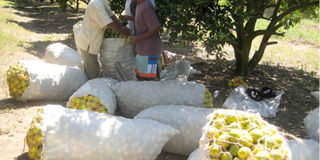Influx of diseases, pests leave citrus farmers in Teso region counting losses

Farmers pack their oranges into sacks for transportation to the market. The increase of pests and diseases are a threat to the busines. Photo by Richard Otim.
What you need to know:
Orange farming is a major agricultural activity in this region but incidences of pests and diseases are a threat.
Though the Teso region is known for growing citrus fruits, hundreds of farmers have lost their yields as pests and diseases cause devastation on farms. Over the last two seasons, there has hardly been a harvest in some places. From Bukedea up to Kaberamaido, occurrences of sweet orange scab, Gummosis, leaf minor, leaf spot and fruit flies are being reported.
Naputali Okello Elepu, a citrus grower in Soroti, thinks the influx of these pests and diseases is fairly recent. He says he first noticed the lesions on the rinds, leaves and twigs in 2011 but did not know then, about sweet orange scab.
Losses
It was only the following year when he consulted the Naads scientists that they identified the disease. It spread through his farm and production dwindled affecting his earnings.
Elepu explains that the oranges are attacked when they start flowering, causing loss of flowers that would be fruits. The few fruits left turn purple and then drop off prematurely.
“I have used various drugs and pesticides, they do not seem to work and yet they are expensive,” he says.
Emmanuel Okello, an orange farmer in Katakwi, says that between 2010 and 2013, he has lost over 100 trees, which kept drying off.
“When I contacted Serere agricultural research station, they confirmed it as Gummosis disease, which is only controllable through proper budding,” he adds. “This season, I expected three tonnes of oranges but with the fruit flies, sweet orange scab and leaf minor, I have lost two and a half tonnes.”
Susceptible
A citrus specialist at National Semi-Arid Resources Research Institute (NaSARRI) in Serere, Joseph Ekwangu, confirms that there are a range of orange diseases and pests in the area.
The most noticed are sweet orange scab, gummosis, leaf minor, leaf spot and fruit flies. He notes that though three of these—sweet orange scab, gummosis and fruit flies—are the most serious, they are controllable.
The most susceptible fruits are tangerine and hybrids, especially during the six to eight weeks after petal fall. To control the scab, one needs to use systemic pesticides and chemicals because when sprayed, the plants absorb them. They are not contact pesticides or chemicals that remain on leaves and are washed off when it rains or by dew.
Warning
Ekwangu outlines Cypermarine mix, Redomic mix and Drythene M45 as some pesticides and chemicals that can help farmers but warns them against expired, diluted or fake products that some unscrupulous dealers sell as the real thing.
However, he also points out, “Some farmers even don’t know when to spray. Normally, between late morning and early afternoon are the best hours.”
For the case of gummosis, it can be dealt if only those who bud orange trees know when to. Improper practices right from the nursery bed are to blame.
Control
Samson Akwenyu, an agricultural extension worker, says leaf minor and leaf spot is caused by a fungus that if not controlled earlier, has severe effects.
It makes the leaves curl and destroys the green pigment used by the plant in manufacturing food. This causes the plant to dry up when starved of nourishment.
To control this, just like for the scab, apply systemic pesticides, preferably Dimetheoate pesticides, that are internally absorbed by the plant.




